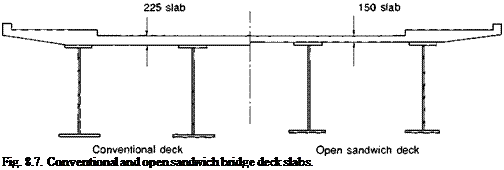The possibilities for making bonded structural sandwich elements in a variety of materials are very real. However, whilst there exist structural examples such as aluminium honeycomb panels (used in aircraft and transport applications) and metal skinned foam sandwich panels (used as the monocoque chassis in refrigerated transport applications), these composite constructions are normally utilised in non — or semi-structural ways. Typical skin materials are steel, aluminium, GRP and plywood, and common core materials are rigid foam polystyrene, polyurethane, polyisocyanurate, PVC, and honeycombed aluminium. In some instances the foam core is injected between the skins and adheres to them; in others, adhesives are used to bond the separate components together. The nature of the manufacturing process depends on the type of structure to be made, and the degree of investment in production machinery. Both flat and complex curved forms can be made by a hand lay-up process as well as in an automated way.
The faces of skins or sandwich panels may be smooth, lightly profiled or heavily profiled, depending on the skin material and intended use. Polymer coated steels or aluminium are common materials for building components, and these may be readily profiled by cold-rolling to confer bending strength. The use of at least one profiled skin is essential for roof members which may be required to withstand long periods of static loading. The choice of colour, construction materials, overall dimensions and the fixing arrange-

Mid span cross-section
ments remain important considerations because they can all influence the performance and long-term integrity of such panels.
Opportunities in civil and structural engineering arise in lightweight structures, or where the high strength-to-weight ratios can be exploited. These may be in bridging large spans or in the development of decking structures. The development of cellular decking structures employing steel skins and reinforced plastic I-beams has been proposed(ll), for which full composite action and maximum bending efficiency could be achieved by bonding the flanges of the I-beams to the skin.
 13 сентября, 2015
13 сентября, 2015  Malyar
Malyar  Опубликовано в рубрике
Опубликовано в рубрике 